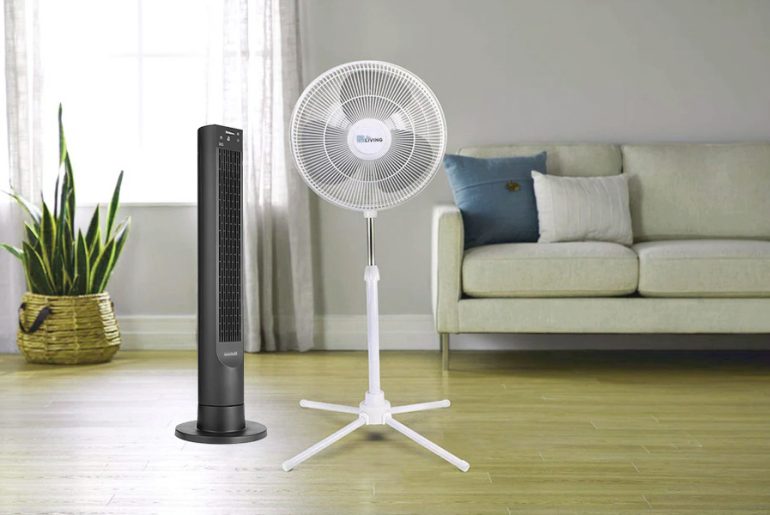Choosing between a tower fan vs pedestal fan can significantly impact your home’s comfort and energy efficiency. These two popular cooling solutions offer distinct advantages, and understanding their differences will help you invest in the right option for your lifestyle. Whether you’re dealing with limited space, specific airflow requirements, or budget considerations, each fan type brings unique benefits to the table.
Modern homes demand versatile cooling solutions that balance performance with practicality. Both tower and pedestal fans have evolved considerably, incorporating advanced features while maintaining their core design principles. Making an informed decision requires examining how each option performs across various criteria that matter most to your daily comfort.
What Makes Tower Fans Unique
Tower fans revolutionize traditional cooling with their innovative vertical architecture. Standing tall and narrow, these units typically measure 30-50 inches in height while occupying minimal floor space. Their bladeless design creates a sophisticated appearance that complements contemporary home decor.
Innovative Engineering Approach
The internal structure utilizes a cross-flow fan mechanism that pulls air through the base and propels it upward through vertical vents. This engineering creates a smooth, consistent airflow without the choppy sensation of spinning blades. Variable speed controls enable users to customize airflow strength according to their comfort preferences.
Airflow Distribution Pattern
Tower fans generate a wide, sweeping airflow that covers more vertical space compared to horizontal alternatives. The air column extends from floor to ceiling, providing cooling across different levels of a room. This vertical distribution pattern proves particularly effective in spaces with high ceilings or multi-level seating arrangements.
Pedestal Fan Fundamentals
Pedestal fans represent time-tested cooling technology with proven effectiveness. These units feature a prominent fan head supported by an adjustable pole, offering flexibility in height and angle positioning. Their traditional design has been refined over decades to maximize air movement efficiency.
Mechanical Simplicity and Power
The exposed blade configuration allows pedestal fans to move substantial air volumes with minimal energy waste. Large diameter blades, typically 16-18 inches, create powerful airflow that can penetrate across rooms effectively. The direct mechanical approach ensures maximum cooling impact per watt consumed.
Directional Control Advantages
Pedestal fans deliver superior focused airflow thanks to their tilting head design. Users can tilt the fan upward, downward, or maintain horizontal positioning based on specific cooling requirements. This directional control proves invaluable for focusing airflow exactly where needed most.
Space Optimization and Room Integration
Room layout considerations often determine which cooling solution works best for specific environments.
Tower Fan Space Management
Tower fans shine in cramped living situations, requiring roughly 12 square inches of floor space. Their slender profile allows placement against walls, in corners, or between furniture pieces without disrupting room flow. This space efficiency makes them ideal for apartments, dorm rooms, or cluttered spaces.
Pedestal Fan Footprint Requirements
Pedestal fans require additional floor area because of their round base and swiveling movement pattern. The base typically spans 18-22 inches diameter, with additional clearance needed for safe oscillation. However, their height adjustability can direct airflow over furniture obstacles that might block tower fans.
Cooling Performance Analysis
Performance differences between these cooling methods become apparent under various usage scenarios.
Air Volume and Circulation Strength
Pedestal fans typically generate higher CFM (cubic feet per minute) ratings, translating to more aggressive air movement. Their concentrated airflow can effectively cool larger areas and overcome warm air pockets. Tower fans provide gentler circulation that many find more comfortable for extended exposure.
Sound Profile Comparison
Tower fans generally operate with reduced noise levels due to their enclosed design and smaller internal components. The multiple miniature fans can achieve adequate airflow at lower rotational speeds. Pedestal fans produce more audible operation, particularly at maximum settings, though quality models minimize noise through aerodynamic blade design.
Energy Consumption and Efficiency
Understanding power usage helps predict long-term operating costs for both fan types.
Power Draw Characteristics
Tower fans generally use between 40-80 watts of electricity based on their dimensions and operating velocity. Their enclosed motors often feature more efficient designs optimized for continuous operation. Pedestal fans range from 55-120 watts, with larger models requiring more power to drive bigger blades at effective speeds.
Operational Cost Projections
While pedestal fans may consume slightly more electricity per hour, their superior air movement can allow lower speed operation to achieve desired cooling. Tower fans compensate for higher per-watt costs through quieter operation that encourages extended use during sleep hours.
Safety Features and Family Considerations
Safety aspects become particularly important in households with children, elderly residents, or pets.
Built-in Protection Systems
Modern tower fans incorporate multiple safety features including tip-over switches, overheating protection, and child-lock controls. The bladeless design eliminates finger injury risks while maintaining effective cooling performance. Many models include safety sensors that detect obstructions or unusual conditions.
Stability and Accident Prevention
Tower fans typically feature weighted bases designed to resist tipping, though their height can make them vulnerable to being knocked over. Pedestal fans present blade exposure concerns despite protective grilles, but their lower center of gravity often provides better inherent stability.
Maintenance Requirements and Longevity
Long-term ownership costs include both maintenance needs and expected lifespan considerations.
Cleaning and Care Procedures
Tower fans require periodic internal cleaning that may necessitate partial disassembly to access accumulated dust and debris. Their enclosed design protects internal components but makes thorough cleaning more challenging. Pedestal fans offer easier access for regular blade and motor cleaning but require more frequent attention.
Durability and Repair Considerations
Pedestal fans typically offer superior repairability due to their straightforward mechanical design and widely available replacement parts. Tower fans may face challenges with proprietary internal components, though their enclosed design often provides better protection against environmental damage and wear.
Investment Analysis and Value Assessment
Budget considerations encompass both initial purchase price and long-term value proposition.
Price Range Overview
Quality tower fans start around $60 and can exceed $250 for premium models with advanced features. Pedestal fans offer broader price flexibility, with effective models available from $40-180. The price difference often reflects manufacturing complexity and included technology features.
Feature Set Comparison
Premium tower fan models frequently feature wireless controls, scheduling functions, air purification technology, and mobile app integration. Premium pedestal fans focus on motor quality, blade optimization, and enhanced stability rather than electronic features. Consider which features align with your actual usage patterns.
Climate and Environmental Factors
Different cooling challenges require specific fan characteristics for optimal performance.
Humidity and Air Quality Impact
Tower fans with built-in air purification features can address both cooling and air quality simultaneously. Their enclosed design protects internal components from dust accumulation better than exposed pedestal fan mechanisms. However, pedestal fans excel in high-humidity environments where maximum air movement is essential.
Seasonal Usage Patterns
Tower fans work well year-round for gentle air circulation, while pedestal fans excel during peak cooling seasons when maximum airflow is prioritized. Consider your climate’s seasonal variations when selecting between these options.
Making Your Decision
Selecting between tower fan vs pedestal fan requires weighing various considerations that match your personal circumstances.
Ideal Tower Fan Scenarios
Choose tower fans for small spaces, quiet operation requirements, modern aesthetic preferences, and safety-conscious households. They work best as personal cooling devices or in spaces where gentle, consistent airflow is preferred over powerful air movement.
Perfect Pedestal Fan Applications
Select pedestal fans for large room cooling, outdoor use, maximum airflow requirements, and budget-conscious purchases. They excel in situations demanding targeted cooling or where traditional reliability takes precedence over modern features.
Conclusion
The tower fan vs pedestal fan decision involves assessing your room dimensions, comfort requirements, and individual preferences. Tower fans offer space-saving design, quiet operation, and modern aesthetics perfect for small areas and bedrooms. Pedestal fans provide powerful airflow, adjustability, and proven reliability ideal for large spaces and demanding cooling applications. Choose based on your primary requirements: tower fans for efficiency and style, pedestal fans for power and versatility. Both deliver effective cooling at a fraction of air conditioning costs.




